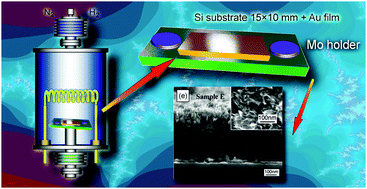Plasma-chemical synthesis, structure and photoluminescence properties of hybrid graphene nanoflake–BNCO nanowall systems
Abstract
We describe a simple, efficient plasma-chemical technique for the synthesis of hybrid structures formed by vertically oriented BNCO nanowalls and vertically oriented graphene nanoflakes (BNCONW/GNFs), as well as their structure and photoluminescence properties. The BNCONW/GNF hybrid structures were fabricated by the synthesis of vertically oriented BNCO nanowalls in N2–H2 plasma using the plasma-enhanced hot filament chemical vapour deposition technique, followed by the direct synthesis of vertically oriented graphene nanoflakes on the BNCO nanowalls in a methane environment using a hot filament chemical vapour deposition method, where the B4C compound was used as the boron and carbon source. The results of field emission scanning electron microscopy, transmission electron microscopy, micro-Raman spectroscopy and X-ray photoelectron spectrometry measurements indicated that the BNCONW/GNF hybrid structures were composed of vertically oriented BNCO nanowalls and vertically oriented graphene nanoflakes. The photoluminescence studies of the vertically oriented BNCONW/GNF hybrid structures using a Ramalog system equipped with a 325 nm He–Cd laser demonstrated the possibility to efficiently tune the photoluminescence properties of the BNCONW/GNF structures by growing the graphene nanoflakes on the vertically oriented BNCONWs. Our findings can contribute to the designing of complex hybrid graphene–semiconductor structures suitable for applications in advanced next-generation optoelectronic nanodevices.


 Please wait while we load your content...
Please wait while we load your content...